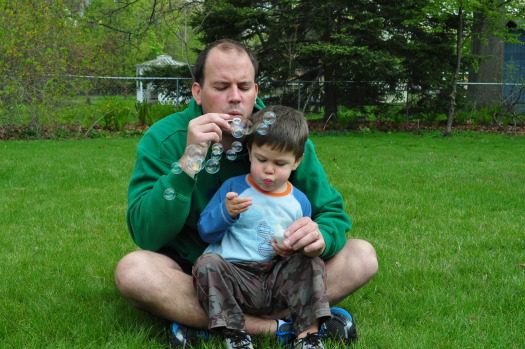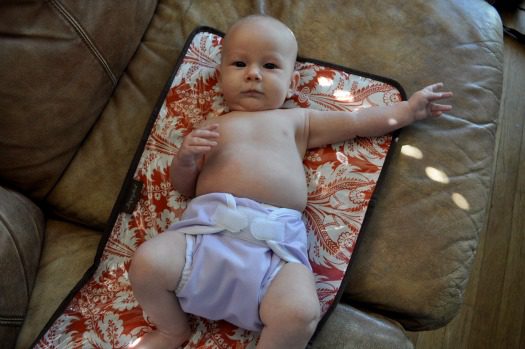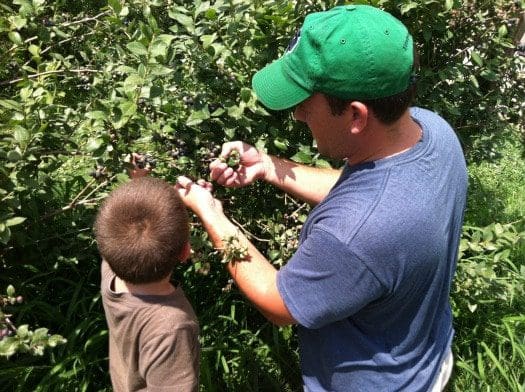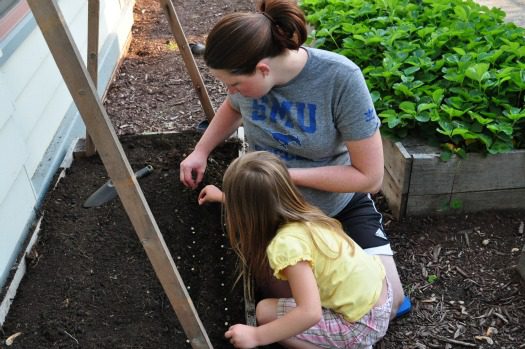The following post is from Emily of Live Renewed: 8 Ways to Go Green with Your Kids

I distinctly remember the day my 3-year-old daughter asked her Nana (my mom) what a paper towel was. Because we don’t use paper towels at home she had never really seen them before and had to ask what they were called. I have to admit, I was kinda proud.
Or there was the time that she gave my brother-in-law a hard time for leaving his TV on during the day for his dog, while he is away at work. “You know how you leave your TV on for Brutus when you’re not home?” she asked. “You shouldn’t do that because it wastes energy!”
My kids yell at each other to turn off the lights in rooms they’re not using, and do not leave the water running in the faucet while they’re washing their hands.
My family began our journey toward more green and natural living around the time that our oldest daughter was born, so our children have grown up with these things as a normal part of their lives. By implementing these ways of going green with your kids from a young age, they will learn the importance of protecting our planet, and it will be a core value to them that they will want to share with others too.

Table of Contents
1. Use cloth diapers and wipes.
Teaching children the importance of using reusable products instead of disposables begins with what you use to cover their bums. Modern cloth diapers are an affordable and surprisingly easy way to reduce the amount of waste that you create for your baby and young toddler!
2. Dress them in used and hand-me-down clothes.
One thing I have learned with having three young children is that kids are hard on their clothes! By dressing them in clothes that I’ve purchased second hand, or received as hand-me-downs, I don’t worry as much about their clothes getting stains on them, and I’m teaching them not to be too wrapped up in their appearance – there are more important things than having the perfect wardrobe.
3. Buy used kids’ toys and gear.
The same thing applies to kids’ toys and gear as clothing- kids are hard on their stuff, and they grow out of things quickly. We like to stock up on quality open-ended toys, and we’ve been able to find great deals at garage sales, consignment sales, and thrift stores on Lincoln Logs, Tinker Toys, LEGO Duplos, puzzles, books, games, and more, teaching our kids that new, fun toys don’t always have to come from the toy store or shiny toy aisles at the big box store.

4. Teach them where whole, real foods come from.
Some of the biggest highlights of our family’s summer are the days that we head out to local u-pick farms to pick a bounty of delicious fruits to bring home and put up to enjoy throughout the year. Our kids are learning that local fruits and vegetables are only available during certain seasons. Then, when they see those same fruits and vegetables available at the store, they know they have grown far away and shipped across the country, and sometimes the world, to get to us.
They’re also learning that the best meat, eggs, and dairy products come from a local farm where the animals are happy and treated humanely. We tell our kids that our farm’s fresh milk comes from happy cows, so one day our son said that milk from the store is from “mad cows”. My husband and I had a good laugh about that!
5. Use safe and natural cleaning products.
Our kids are growing up learning that there are chemicals in most of the products that are available around us every day and that we try to avoid those chemicals as much as we can. The best part about using safe and non-toxic cleaning products is that your kids can help clean right alongside you!
6. Use safe and natural bath products.
It’s important to protect our kid’s growing little bodies from the toxins and chemicals that are found in personal care products. Our kids are drawn to the colorful children’s bath products covered with their favorite cartoon characters, but we are trying to teach them to be conscious consumers from a young age, knowing that just because a product looks great, or the commercial shows that it’s fun for kids, doesn’t mean it is something they should be using.
7. Teach them the importance of recycling and composting.
Our kids know that scrap paper, most plastic, cans, and glass jars or bottles belong in the recycling bin and that most of our food scraps belong in the compost pail. One of our kids’ jobs in the kitchen is to help with taking the compost pail out and dumping it in the compost pile.
They like to help turn the compost pile and watch as the food scraps and yard waste decompose and turn into soil that we can use in our garden. They are learning that we try to reduce our waste as much as we can by reusing items, recycling, and composting.

8. Let them help you in the garden.
Spring is looking a long way off for us here in Northern Indiana as we woke up to snow again this morning, but my kids are itching to get out and get started on planting our garden. They love to dig in the dirt (what kid doesn’t!), and help plant the seeds, watch them grow and harvest the vegetables when they are ready. It’s another way that we teach them where food comes from and how it grows.
There are lots of fun ways to get our kids involved with green living. They will grow up with a respect for the world and it’s resources, and will pass those values along to their children one day as well, helping to ensure that the earth is a safe place to live for future generations!
How do you teach your kids the importance of protecting the planet and conserving it’s resources?
| Emily McClements strives to live with compassion and caring for creation in a way that will impact the world. She is a blessed wife and mama to three young children, and blogs about her family’s journey toward natural and simple living at Live Renewed. | |




